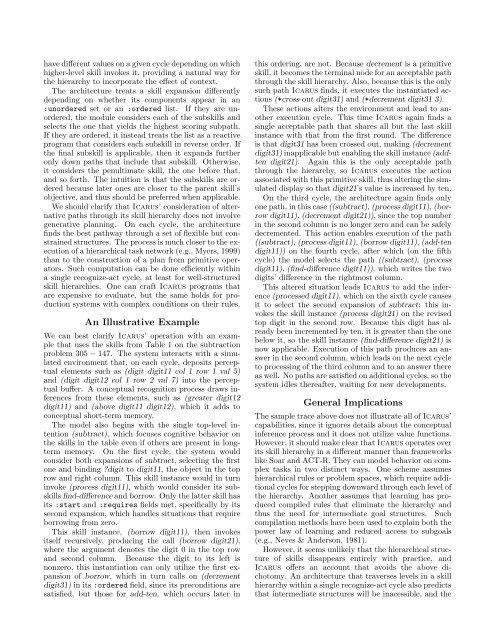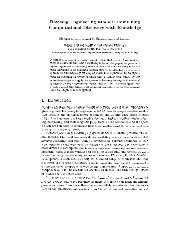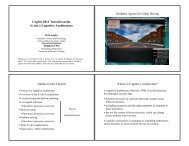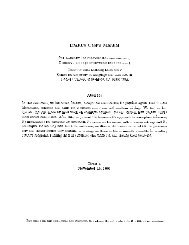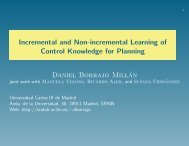Hierarchical Skills and Cognitive Architectures - Computational ...
Hierarchical Skills and Cognitive Architectures - Computational ...
Hierarchical Skills and Cognitive Architectures - Computational ...
You also want an ePaper? Increase the reach of your titles
YUMPU automatically turns print PDFs into web optimized ePapers that Google loves.
have different values on a given cycle depending on which<br />
higher-level skill invokes it, providing a natural way for<br />
the hierarchy to incorporate the effect of context.<br />
The architecture treats a skill expansion differently<br />
depending on whether its components appear in an<br />
:unordered set or an :ordered list. If they are unordered,<br />
the module considers each of the subskills <strong>and</strong><br />
selects the one that yields the highest scoring subpath.<br />
If they are ordered, it instead treats the list as a reactive<br />
program that considers each subskill in reverse order. If<br />
the final subskill is applicable, then it exp<strong>and</strong>s further<br />
only down paths that include that subskill. Otherwise,<br />
it considers the penultimate skill, the one before that,<br />
<strong>and</strong> so forth. The intuition is that the subskills are ordered<br />
because later ones are closer to the parent skill’s<br />
objective, <strong>and</strong> thus should be preferred when applicable.<br />
We should clarify that Icarus’ consideration of alternative<br />
paths through its skill hierarchy does not involve<br />
generative planning. On each cycle, the architecture<br />
finds the best pathway through a set of flexible but constrained<br />
structures. The process is much closer to the execution<br />
of a hierarchical task network (e.g., Myers, 1999)<br />
than to the construction of a plan from primitive operators.<br />
Such computation can be done efficiently within<br />
a single recognize-act cycle, at least for well-structured<br />
skill hierarchies. One can craft Icarus programs that<br />
are expensive to evaluate, but the same holds for production<br />
systems with complex conditions on their rules.<br />
An Illustrative Example<br />
We can best clarify Icarus’ operation with an example<br />
that uses the skills from Table 1 on the subtraction<br />
problem 305 − 147. The system interacts with a simulated<br />
environment that, on each cycle, deposits perceptual<br />
elements such as (digit digit11 col 1 row 1 val 5)<br />
<strong>and</strong> (digit digit12 col 1 row 2 val 7) into the perceptual<br />
buffer. A conceptual recognition process draws inferences<br />
from these elements, such as (greater digit12<br />
digit11) <strong>and</strong> (above digit11 digit12), which it adds to<br />
conceptual short-term memory.<br />
The model also begins with the single top-level intention<br />
(subtract), which focuses cognitive behavior on<br />
the skills in the table even if others are present in longterm<br />
memory. On the first cycle, the system would<br />
consider both expansions of subtract, selecting the first<br />
one <strong>and</strong> binding ?digit to digit11, the object in the top<br />
row <strong>and</strong> right column. This skill instance would in turn<br />
invoke (process digit11), which would consider its subskills<br />
find-difference <strong>and</strong> borrow. Only the latter skill has<br />
its :start <strong>and</strong> :requires fields met, specifically by its<br />
second expansion, which h<strong>and</strong>les situations that require<br />
borrowing from zero.<br />
This skill instance, (borrow digit11), then invokes<br />
itself recursively, producing the call (borrow digit21),<br />
where the argument denotes the digit 0 in the top row<br />
<strong>and</strong> second column. Because the digit to its left is<br />
nonzero, this instantiation can only utilize the first expansion<br />
of borrow, which in turn calls on (decrement<br />
digit31) in its :ordered field, since its preconditions are<br />
satisfied, but those for add-ten, which occurs later in<br />
this ordering, are not. Because decrement is a primitive<br />
skill, it becomes the terminal node for an acceptable path<br />
through the skill hierarchy. Also, because this is the only<br />
such path Icarus finds, it executes the instantiated actions<br />
(*cross-out digit31) <strong>and</strong> (*decrement digit31 3).<br />
These actions alters the environment <strong>and</strong> lead to another<br />
execution cycle. This time Icarus again finds a<br />
single acceptable path that shares all but the last skill<br />
instance with that from the first round. The difference<br />
is that digit31 has been crossed out, making (decrement<br />
digit31) inapplicable but enabling the skill instance (addten<br />
digit21). Again this is the only acceptable path<br />
through the hierarchy, so Icarus executes the action<br />
associated with this primitive skill, thus altering the simulated<br />
display so that digit21’s value is increased by ten.<br />
On the third cycle, the architecture again finds only<br />
one path, in this case ((subtract), (process digit11), (borrow<br />
digit11), (decrement digit21)), since the top number<br />
in the second column is no longer zero <strong>and</strong> can be safely<br />
decremented. This action enables execution of the path<br />
((subtract), (process digit11), (borrow digit11), (add-ten<br />
digit11)) on the fourth cycle, after which (on the fifth<br />
cycle) the model selects the path ((subtract), (process<br />
digit11), (find-difference digit11)), which writes the two<br />
digits’ difference in the rightmost column.<br />
This altered situation leads Icarus to add the inference<br />
(processed digit11), which on the sixth cycle causes<br />
it to select the second expansion of subtract; this invokes<br />
the skill instance (process digit21) on the revised<br />
top digit in the second row. Because this digit has already<br />
been incremented by ten, it is greater than the one<br />
below it, so the skill instance (find-difference digit21) is<br />
now applicable. Execution of this path produces an answer<br />
in the second column, which leads on the next cycle<br />
to processing of the third column <strong>and</strong> to an answer there<br />
as well. No paths are satisfied on additional cycles, so the<br />
system idles thereafter, waiting for new developments.<br />
General Implications<br />
The sample trace above does not illustrate all of Icarus’<br />
capabilities, since it ignores details about the conceptual<br />
inference process <strong>and</strong> it does not utilize value functions.<br />
However, it should make clear that Icarus operates over<br />
its skill hierarchy in a different manner than frameworks<br />
like Soar <strong>and</strong> ACT-R. They can model behavior on complex<br />
tasks in two distinct ways. One scheme assumes<br />
hierarchical rules or problem spaces, which require additional<br />
cycles for stepping downward through each level of<br />
the hierarchy. Another assumes that learning has produced<br />
compiled rules that eliminate the hierarchy <strong>and</strong><br />
thus the need for intermediate goal structures. Such<br />
compilation methods have been used to explain both the<br />
power law of learning <strong>and</strong> reduced access to subgoals<br />
(e.g., Neves & Anderson, 1981).<br />
However, it seems unlikely that the hierarchical structure<br />
of skills disappears entirely with practice, <strong>and</strong><br />
Icarus offers an account that avoids the above dichotomy.<br />
An architecture that traverses levels in a skill<br />
hierarchy within a single recognize-act cycle also predicts<br />
that intermediate structures will be inacessible, <strong>and</strong> the


